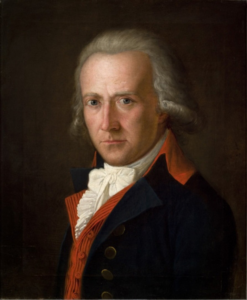The dance of the spirits
(Poet's title: Der Geistertanz)
Set by Schubert:
D 15
[circa 1812]
D 15A
[circa 1812]
D 116
[October 14, 1814]
D 494
TTBBB quintet[November 1816]
Die bretterne Kammer
Der Toten erbebt,
Wenn zwölfmal den Hammer
Die Mitternacht hebt.
Rasch tanzen um Gräber
Und morsches Gebein
Wir luftigen Schweber
Den sausenden Reihn.
Was winseln die Hunde
Beim schlafenden Herrn?
Sie wittern die Runde
Der Geister von fern.
Die Raben entflattern
Der wüsten Abtei
Und fliehn an den Gattern
Des Kirchhofs vorbei.
Wir gaukeln, wir scherzen
Hinab und empor,
Gleich irrenden Kerzen
Im dunstigen Moor.
O Herz, dessen Zauber
Zur Marter uns ward,
Du ruhst nun in tauber
Verdumpfung erstarrt.
Tief bargst du im düstern
Gemach unser Weh;
Wir Glücklichen flüstern
Dir fröhlich: Ade!
The wooden chamber
Of the dead shakes
When the hammer rises twelve times
And strikes midnight.
We dance quickly around graves
And rotten bones.
Suspended in the air
We whizz about in formation.
Why are the dogs whimpering
By their sleeeping masters?
They can sense the circling
Spirits in the distance.
The ravens fly off
Away from the deserted abbey
And fly past the railings
Of the churchyard.
We flutter, we tease,
Down we go and up
Like deceptive candles
On a misty moor.
Oh heart, whose magic
Became torment to us,
You are now at rest, in numb
Putrefaction, paralysed.
You have buried it deep in a gloomy
Chamber, our agony.
We lucky ones whisper
Joyfully to you: Farewell!
All translations into English that appear on this website, unless otherwise stated, are by Malcolm Wren. You are free to use them on condition that you acknowledge Malcolm Wren as the translator and schubertsong.uk as the source. Unless otherwise stated, the comments and essays that appear after the texts and translations are by Malcolm Wren and are © Copyright.
☙
Themes and images in this text:
Bones and skeletons Dancing Dogs Farewell and leave taking Graves and burials Hearts Heathland and moors Midnight Mist and fog Night and the moon Ravens Will o’the wisp (ignis fatuus)
‘Pulvis et umbra sumus’ (Horace, Odes IV, vii) was Matthisson’s superscription on this poem: “We are dust and shadows”.
We humans (and poets in particular) like to flatter ourselves on our sensitivity, but Matthisson admits the truth: dogs often know more. We know from dog whistles and the early stages of earthquakes and volcanic eruptions that they have a capacity to detect minimal changes in the environment that we cannot register. Might they, then, not also be aware of departed spirits dancing around a graveyard at midnight? The birds too seem to know. A flock of ravens takes off, passing the graveyard gate, vacating the dance floor; it is time for the spirits to get in formation for their dances.
The only human beings in this poem are either sleeping, insensate dog-owners or dead bodies. The heart, once a magical engine of feeling (though the poet only refers explicitly to the torment it created), is now numb and rotting. If anyone is still awake or alive or conscious they will be teased by that northern or Gothick mirage, the will o’ the wisp, here presented as confusing or crazy candles on a misty moor. Of course, these lights are flickering. The whole point is that they are not fixed. They do not offer any form of stability or illumination. They do, however, suggest movement and they may intimate our proximity to another, less fixed, dimension.
The metaphor of the dance might be inviting us to leap across the abyss, to cross from numbness and putrefaction into a different kind of lightness. The wooden box we are all in might shake us out of our paralysis. We might wake up and become aware of the presences that our dogs are already alert to.
☙
Original Spelling Der Geistertanz Die bretterne Kammer Der Todten erbebt, Wenn zwölfmal den Hammer Die Mitternacht hebt. Rasch tanzen um Gräber Und morsches Gebein Wir luftigen Schweber Den sausenden Reihn. Was winseln die Hunde Beim schlafenden Herrn? Sie wittern die Runde Der Geister von fern. Die Raben entflattern Der wüsten Abtei, Und fliehn an den Gattern Des Kirchhofs vorbey. Wir gaukeln, wir scherzen Hinab und empor Gleich irrenden Kerzen Im dunstigen Moor. O Herz! dessen Zauber Zur Marter uns ward, Du ruhst nun, in tauber Verdumpfung, erstarrt. Tief bargst du im düstern Gemach unser Weh; Wir Glücklichen flüstern Dir fröhlich: Ade!
Confirmed by Peter Rastl with Schubert’s source, Gedichte von Matthisson. Neueste verbesserte Auflage. Wien und Prag bey Franz Haas 1810. pages 136-137; with Gedichte von Friedrich von Matthisson. Zweiter Theil. Tübingen, bei Cotta, 1811, pages 104-105, and with Schriften von Friedrich von Matthisson, Volume 1, third edition, Zürich: Orell, Füßli und Compagnie, 1825, pages 222-223.
To see an early edition of the text, go to page 136 [144 von 296] here: http://digital.onb.ac.at/OnbViewer/viewer.faces?doc=ABO_%2BZ169509602


